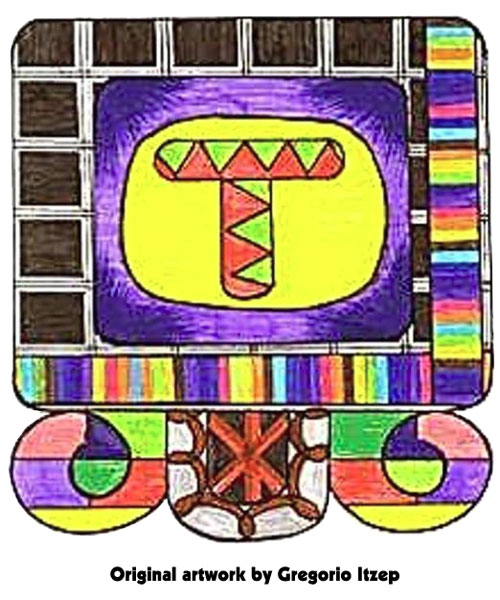
Ik Trecena
by Kenneth Johnson
This powerful day-sign is, at the same time, one of the most spiritual and one of the most potentially dangerous of all the naguales.
The Aztecs placed this day under the rulership of Quetzalcoatl, the Feathered Serpent. Quetzalcoatl, in addition to his role as the god of the morning star—the planet Venus—was also the god of the wind. As a wind god, he was called by the name Ehecatl. The creation of all things is described in the opening pages of the Popol Vuh, the creation epic of the K’iche’ Maya. Here, Lord Feathered Serpent (Tepeu Q’ucumatz in the K’iche’ language) emerges as part of the creative energy of the universe itself.
The Maya typically describe creation as an interplay of positive and negative polarities not dissimilar to the Chinese concept of yin and yang. This duality of creation can also be expressed as “Heart of Sky, Heart of Earth.” The term Heart of Sky refers to the god known as Hun Rakan – or, to use one of the few Mayan words that has been adopted into English, “Hurricane.” This deity is the primal spirit of the wind and the air. If Lord Feathered Serpent is an aspect of the day-sign Ik as god of the wind, so is Hun Rakan, the Heart of Sky. As the creative power of the air, Ik represents the Breath of Life itself, a force which has many similarities to the Hindu concept of prana, which is yet another metaphor for breath or air as the creative energy of life. Almost all of the world’s spiritual traditions speak of the subtle or vital breath which is often the instrument of creation itself. In the Book of Genesis, the “Spirit of God moved upon the face of the waters” (1:2). The original Hebrew word for “spirit” is ruach. It is the vital breath of God that is active at the moment of creation. In Greek myth, Prometheus breathes his pneuma into the inanimate clay figure of the first man in order to bring him to life. In an old Aztec codex which correlates the day-signs with the human body, Wind corresponds to the upper part of the diaphragm that fills with air during yogic breathing exercises. Because we breathe, we live.
But the same wind which breathes life into our nostrils may also be a destructive power. After all, this day-sign is the origin of our word “hurricane.” The wind that nurtures and vivifies us may also become one of the most destructive forces on earth. The Breath of Life may manifest as a raging hurricane. Among the contemporary K’iche’, Ik is one of the four day-signs which may become the Lord of the Year; and, according to the Maya, it is the most potentially dangerous of the four. During an Ik year, one may expect events that batter the world with the force of a tropical storm. This is a year which the Maya associate with revolutions, insurrections, and political disturbances of all kinds.
Without the symbiosis of trees and wind, there would be no life on earth, nothing to breathe. What better symbol for the breath of life, then, than the T-cross with its dual meaning of “tree” and “breath”?
The glyph for this day-sign is the T-cross. This T is known throughout Mesoamerica and the American Southwest. In some of the ancient codices or sacred books of the Aztecs and Mayas, the Tree of Life itself is shaped like a T, reminding us that trees play a role in the renewal of the world’s oxygen—trees and the air are intimately linked. There are t-shaped windows as far south as Palenque and t-shaped doorways as far north as Chaco Canyon in New Mexico. The same hieroglyphic element is also found on the ceremonial garments of present-day Pueblo Indians; I have seen many head-pieces used by Pueblo women in the Corn Dance which bear the “t-shape” of the day-sign Ik.
Among its many other meanings, the name of this day-sign, which is iq’ in K’iche’, is also the common term for the lunar month.
Ik is the wind which sweeps clean our house and our body. At this time we ask for the strength, the vitality, and the commitment to carry on in our chosen work. This is a day for the removal of negative energy and illnesses; in terms of healing, it favors the resolution of psychological problems, especially those which arise from angry emotional states.
http://www.jaguarwisdom.org

